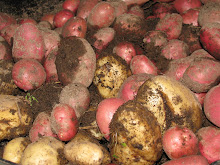By GLENN COLLINS
But will people buy them?
Vegetables, that is. Certainly on Wednesday afternoon, an urgent line formed at a cheery new produce cart that had materialized at the corner of East Fordham Road and Decatur Avenue near Fordham University in the Bronx.
“These strawberries look great, and they’re a bargain,” said Michelle Cruz, a 38-year-old graphic designer who lives nearby and found herself jostling other produce hounds under the cart’s jaunty green umbrellas.
The cart’s debut was the centerpiece of the first public celebration of a new citywide effort to encourage street vendors to bring fresh vegetables and fruit to low-income neighborhoods that have been called “food deserts” because of the predominance of fast-food outlets offering high-fat, high-sugar fare and the dearth of healthful culinary fare.
The city has approved 1,000 new mobile food carts for neighborhoods in the five boroughs that have long been isolated from traditional supermarkets, grocery stores and farmers’ markets offering fresh produce at reasonable prices.
“There is an epidemic of obesity and diabetes among those who are poor,” said Linda I. Gibbs, the deputy mayor for health and human services.
So far, 200 Green Carts, as they are officially called, are now on the streets. “Already, people are telling us they’re glad we’re here,” said Michael Bracho, the 42-year-old proprietor of the Decatur Avenue cart, a downsized former Office Depot manager who describes his new occupation as “lucrative if you do it right.”
Some of the vendors who hit the streets last year complained about low-traffic locations, and it will take a while to determine whether there is enough demand to keep all the vendors in business in neighborhoods where processed foods are dominant. And some local merchants could see the carts as competition.
The carts do not accept food stamps, though a government-financed pilot program will soon provide $1,000 all-weather wireless terminals so 15 vendors can accept food-stamp debit cards.
The cart permits restrict operators to designated impoverished neighborhoods in the five boroughs and limit sales to raw fruits and vegetables.
The plan, approved by the New York City Council and signed into law by the mayor last year, is part of a public-private effort to make healthier food available to the poor while also providing 1,000 new jobs. Many vendors are immigrants from Latin America, Asia and elsewhere, said Karen Karp, a consultant to the project.
In low-income neighborhoods, “we know that it takes more time to build supermarkets,” said Benjamin Thomases, the food-policy coordinator for the Bloomberg administration, “but we can get carts on the streets right now.”
Even if doctors talk to their patients about eating in a more healthy way, “there is little access to these kinds of foods in minority communities,” said Dr. Peter A. Selwyn, a department chairman at Montefiore Medical Center in the Bronx.
“There’s third-rate stuff around here if you can even find it,” said Tom Johnson, a 25-year-old maintenance worker, as he stood amid the frenzy at the cart. “I can buy here now.”
People working two jobs “are not going to get on a train, or two buses, to travel to get fresh vegetables,” said Laurie M. Tisch, president of the Illumination Fund, a charity that has donated $1.5 million over two years to provide capital for Green Cart micro-loans for basic purchases, like the $2,000 food carts, through Acción New York, a nonprofit organization that helps those who do not qualify for bank credit.
But not everyone in the Fordham neighborhood was in a celebratory mood. “It may be good for health, but it’s bad for business,” said George Katehis, manager of the Splendid Deli Restaurant at 387 East Fordham Road. “A guy might buy a piece of fruit there instead of coming in here for a soda.”
Fruits and vegetables were available, but the prices were higher, at the Compare Foods market at East 189th Street and Park Avenue, a few blocks away from the Green Cart. Bananas were 99 cents a pound instead of 50 cents, strawberries were $3.99 a container instead of $1.50 and peppers were $1.89 a pound instead of $1.
“Maybe we’ll lose some customers to them,” said the manager, who gave his name only as Fabio V., adding that his produce cost more because “I have to pay utilities, high rent, employees — and he doesn’t.”
If the avid buyers at Decatur Avenue were any indication, residents of produce-poor neighborhoods may welcome the green-umbrella invasion. “Research has demonstrated that the greater the access, the more the consumption,” said Elliott S. Marcus, an associate commissioner of the city’s health department.
Mr. Marcus, who knows of no similar program in any other city, is hopeful that the Green Carts operation will inspire imitators.
Kumar Gouranga, a 45-year-old immigrant from Bangladesh who for three months has operated a cart at 165th Street and Broadway in Manhattan, said that “business is so good that we are staying open 24 hours a day, seven days a week.”
Mr. Gouranga said his worst problem had been the 15 tickets he had received from the police, despite his legal permit. He said that every ticket had been dismissed in court, but that new ones kept coming.
“My other problem is that the green umbrella you get breaks easily,” he said, “especially in high winds.”
Monday, June 15, 2009
Subscribe to:
Post Comments (Atom)

No comments:
Post a Comment